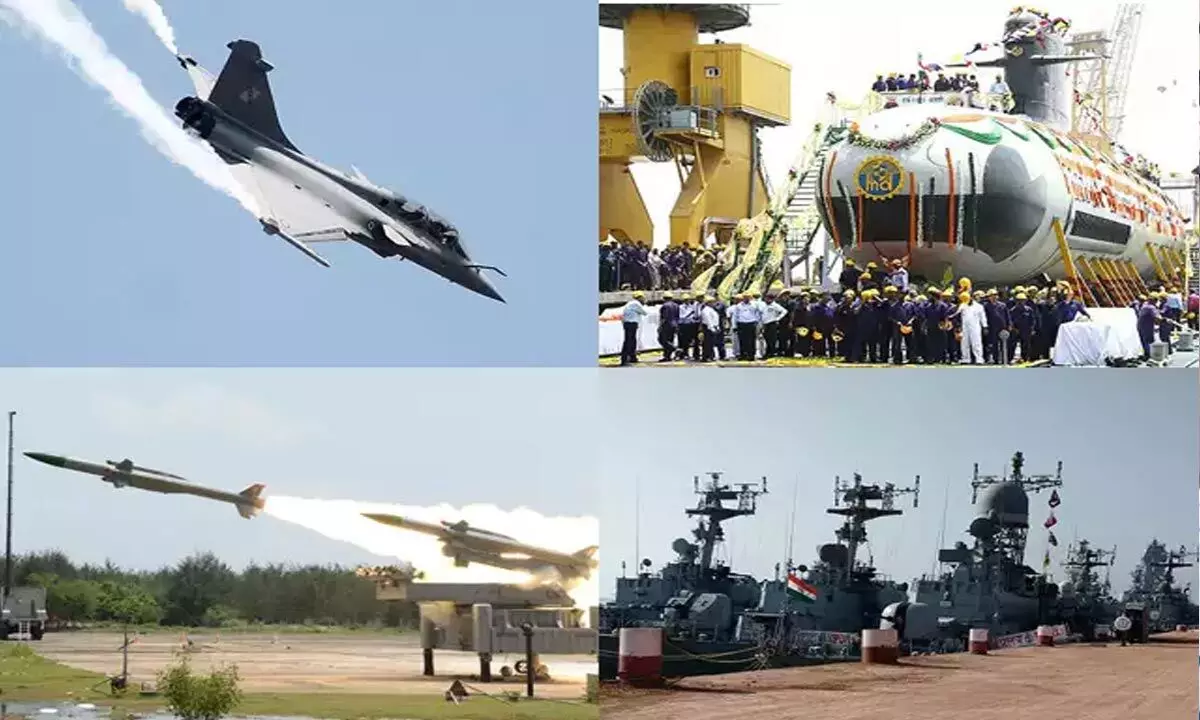India's woes in defence preparedness
India’s combat readiness has been affected due to various technical problems and because of missing spare parts, which are facing delays on account of the war in Europe
image for illustrative purpose

The situation with the air force is particularly dire. By 2030, the Indian Air Force maybe left with less than 30 fighter squadrons, well below the 42 the military says it needs to adequately protect borders with both China and Pakistan, officials said. Between now and then, the air force will be forced to ground about half-a-dozen squadrons - each including 16 to 18 fighter jets - that will reach the end of their flying life
Prime Minister Narendra Modi's push to boost domestic manufacturing of defense systems is leaving India vulnerable to persistent threats from China and Pakistan, according to officials with knowledge of the matter.
Modi's program mandates 30-60 per cent of home-made components, depending on the nature of the military purchase or where it's purchased from. There were no such caps earlier and India used a system of ploughing back a certain percentage of the cost of the purchase into domestic manufacturing.
Roughly 70 to 85 per cent of India's military platforms are of Russian origin, a 2020 assessment by US think tank Stimson Center said. It makes Russia the biggest exporter of military hardware to India. About 90 per cent of the Indian Army's equipment comes from Russia, while the Indian Navy's share of Russian equipment is, in contrast, estimated at 40 per cent. Around 70 per cent of the equipment of the India Air Force (IAF) is of Russian origin.
Given the two-front tensions that India faces, including an ongoing, two-year-long battle of attrition with China in Ladakh, there is very little breathing space.
India's air force, army, and navy can no longer import some critical weapons systems to replace aging ones, the officials said. That risks leaving India critically short of helicopters by 2026 and with a shortfall of hundreds of fighter jets by 2030, they said.
According to one official, who spoke on condition of anonymity, around 70 per cent of Indian T-72s may not be ready for combat. The combat readiness has been affected "due to various technical problems and because of missing spare parts, which are facing delays on account of the war in Europe", he said.
According to western and Ukrainian estimates, more than 2,200 Russian tanks have been destroyed in the war so far, and the numbers could well be higher. Even if Ukrainian information can be discounted in the fog of war, there is enough evidence to suggest that the Russian tanks, many among them T-272s, have been sitting ducks for US-supplied Javelin anti-tank missiles and UK-produced next-generation light anti-tank weapon missiles (NLAWs).
Regarding submarines, the eight Kilo-class submarines acquired from Russia form the bulk of India's fleet. And New Delhi also remains intent on the lease of a third Russian nuclear-powered attack submarine (SSN), Chakra-III.
The Sukhoi Su-30 MKI fighters constitute about 14 of the IAF's 30 squadrons. There are also MiG-29UPG and MiG-21 fighters, IL-78 tankers, as well as two IL-76 aircraft that have been converted to carry airborne warning and control systems that India has bought from Israel.
As things stand, India's military readiness is set to further deteriorate just as it faces greater risks from Pakistan and China, which has soldiers deployed toe-to-toe against troops from India along their Himalayan border following deadly clashes in 2020. The weaker air force in particular means India will need twice the number of soldiers on the ground to deter aggression along the Chinese border, one person said.
The situation with the air force is particularly dire. By 2030, the Indian Air Force maybe left with less than 30 fighter squadrons, well below the 42 the military says it needs to adequately protect borders with both China and Pakistan, officials said. Between now and then, the air force will be forced to ground about half-a-dozen squadrons - each including 16 to 18 fighter jets - that will reach the end of their flying life, one official said.
The IAF is considering 20 Tejas squadrons, including 12 Tejas Mark-2, a wholly different aircraft. First, a Preliminary Air Staff Quality Requirement (PASQR) is formulated jointly with IAF and HAL, followed by the Air Staff Qualitative Requirements (ASQR).
The fact that HAL was not found fit to build Rafale in its 79th year of existence is evidence that the organisation has to have its most significant flaws addressed. Helicopters are another problem. Almost 80 per cent of India's fleet of choppers has already outlived their lifespan of 30 years, a defense ministry official said.
Most of the army's fleet of single-engine choppers will have to be grounded by 2026 even though domestically made light helicopters aren't likely to be ready before the end of 2030, one defense official said.
The great bulk of our military services' aircraft and helicopters, as well as their engines and ancillary components, are manufactured, repaired, and serviced by different divisions of the Indian Aerospace behemoth Hindustan Aeronautics Limited (HAL). The effectiveness and expansion of this aeronautics giant are crucial not only for the combat effectiveness of our military but also for the future of our aerospace sector.

